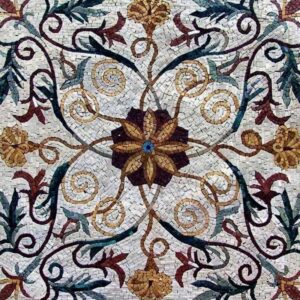
Mosaic art is a very old art form that involves creating images or patterns by assembling small, colored pieces of materials into a larger, cohesive design. These small pieces, known as “tesserae,” can be made of various materials, including glass, ceramic, stone, and even wood. Mosaic art can be found in cultures around the world and throughout history, from ancient Roman and Greek mosaics to modern creations.

In inlay flooring work, the pieces are inserted into a surface that has been hollowed out to receive the design pattern; whereas, in mosaic flooring work, the pieces are applied to a surface that has been prepared using an adhesive.
Mosaic art utilizes a variety of materials, known as tesserae, to create intricate and colorful designs. Here are some of the common materials used in mosaic art work:
To make amazing mosaics, various techniques are used, each with its own distinct procedure and decorative outcome. Here are some of the common techniques used in mosaic flooring work:
There are many applications for mosaic art in both decorative and practical contexts. Here are some of the common applications of mosaic:
Mosaic flooring is known for its durability, as it is a popular choice for both residential and commercial spaces.The durability of mosaic flooring depends on several factors, including the quality of materials, installation, and maintenance. Here are some of factors which increases durability of mosaic flooring:
So, when mosaic flooring is well-designed, installed correctly, and properly maintained, it can last for many years, even decades. It is prized for its resistance to wear and the ability to maintain its artistic and decorative qualities over time.
Are you looking for the Mosaic work in your home? Then stop looking for more and allow us to provide you with the best in class work and mosaic design which is special for your place. We Attari Marble Art has more than 20 years experience in mosaic and inlay flooring work. Our expert team is capable of using all of the techniques with the new advanced tools which will deliver a perfect and best in class mosaic designed on surfaces. We provide a variety of options for mosaic work designs for clients’ homes, offices, schools, restaurants, and hotels, among other locations.
Use this feature to chat with our agent.